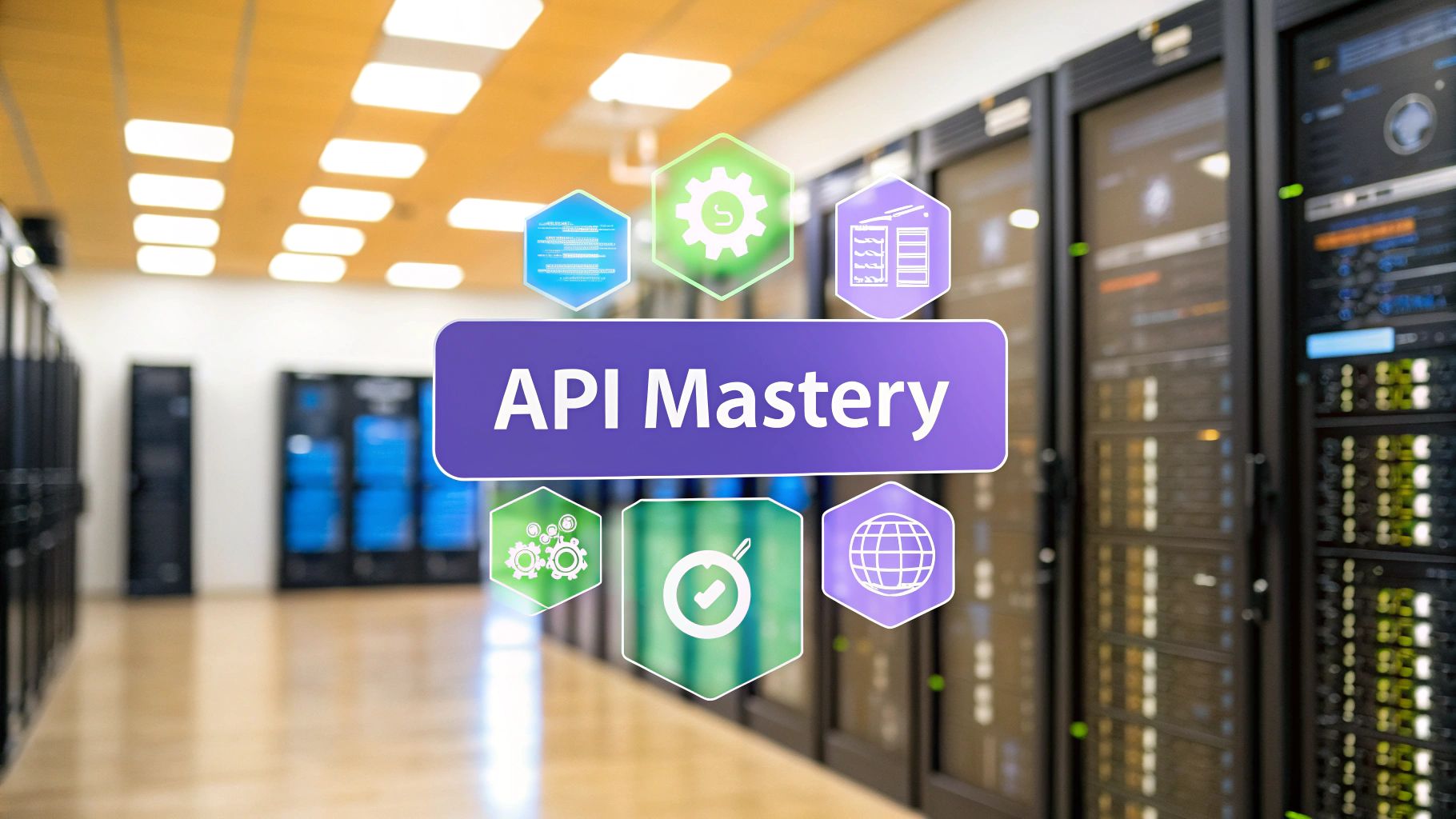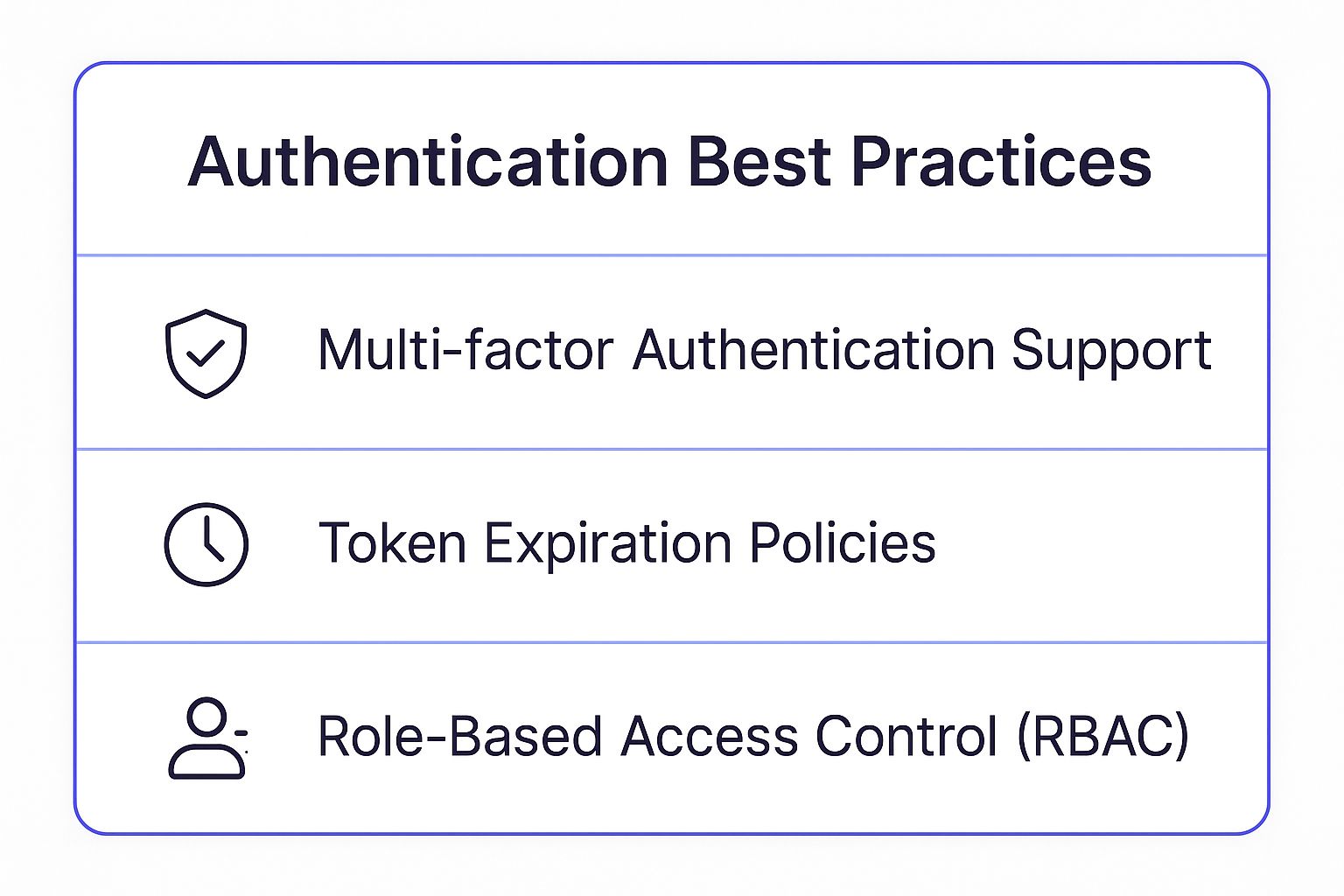
In today's interconnected ecosystem, APIs (Application Programming Interfaces) are the bedrock of modern software, enabling disparate systems to communicate and share data seamlessly. However, building a functional API is only the first step. Creating a robust, secure, and scalable integration is what separates successful platforms from vulnerable ones that expose businesses to unnecessary risk. Poorly designed integrations can lead to security breaches, performance bottlenecks, and a frustrating developer experience, ultimately undermining critical business goals.
As companies increasingly rely on interconnected services-from payment gateways to AI-driven platforms-adhering to established API integration best practices is no longer just a recommendation; it's a critical necessity for maintaining operational integrity and competitive advantage. Before diving into the intricacies of these practices, it's crucial to begin with a solid foundational knowledge, starting with understanding what API integrations are and why they form the backbone of modern digital architecture.
This guide provides a comprehensive roundup of essential best practices that will empower you to build resilient and efficient API integrations. We will move beyond generic advice to offer actionable insights and specific implementation details on key areas, including:
By mastering these concepts, you can ensure your systems are secure, scalable, and prepared for the demands of a connected future. Let's explore the practices that will fortify your integration strategy.
Securing your API is not an optional step; it's the foundational layer of trust between your service and its consumers. Implementing robust authentication and authorization is a critical API integration best practice that ensures only verified and permitted users or applications can access your endpoints. This dual-layered approach protects sensitive data, prevents misuse, and maintains the integrity of your platform.
Authentication verifies the identity of the client making the request, while authorization determines what actions that authenticated client is allowed to perform. Without them, your API is an open door, leaving sensitive user data and critical business operations vulnerable to unauthorized access and manipulation.
A solid security model builds confidence among your partners and customers, encouraging wider adoption. When a developer integrates with your API, they are entrusting you with their data and their users' data. A weak security posture can lead to catastrophic data breaches, reputational damage, and loss of business.
Consider the Stripe API, which uses secret keys for authentication. It provides different keys for different environments (test vs. live) and allows for restricted keys that have limited permissions, perfectly illustrating the principle of least privilege. Similarly, the Google APIs leverage the OAuth 2.0 framework, which allows users to grant specific permissions (scopes) to third-party applications without sharing their passwords.
To effectively secure your API, focus on proven industry standards and avoid creating custom security schemes, which are often prone to undiscovered vulnerabilities.
The following infographic highlights three core pillars for creating a secure authentication and authorization system.

This visual summary emphasizes that a comprehensive strategy combines identity verification, time-bound access, and granular permissioning to create multiple layers of defense. Implementing these three concepts is a significant step toward a resilient and trustworthy API security model.
The design of your API endpoints is the user interface for developers. Creating RESTful endpoints with consistent naming conventions, proper HTTP methods, and logical resource hierarchies is a critical API integration best practice. This approach makes your API intuitive, predictable, and easy to integrate, significantly reducing the learning curve for developers and accelerating adoption.

This practice involves adhering to the principles of Representational State Transfer (REST), an architectural style popularized by Roy Fielding. A well-designed, RESTful API feels like a natural extension of the web itself, using standard HTTP protocols in a way that developers inherently understand. Consistency across all endpoints ensures that once a developer learns how to interact with one part of your API, they can apply that knowledge everywhere else.
An inconsistent or poorly designed API forces developers to constantly consult documentation, leading to frustration, integration errors, and slower development cycles. A logical and predictable API, on the other hand, empowers developers to build integrations quickly and with confidence. This positive developer experience is a competitive advantage that fosters a strong community and encourages long-term partnerships.
Consider the GitHub REST API, which provides a clear, resource-based structure. Endpoints like /repos/{owner}/{repo}/issues are immediately understandable. Similarly, the Shopify REST Admin API uses a consistent model for managing e-commerce resources like products and orders, making it a benchmark for clear API design. This predictability is a key reason these platforms have such robust third-party ecosystems.
Effective RESTful design is about clarity and adhering to established conventions. By following these strategies, you can create an API that is not only powerful but also a pleasure to use.
/users or /orders instead of verbs like /getUsers or /createOrder. The action is defined by the HTTP method (e.g., GET /users, POST /orders).{ "error": { "code": "not_found", "message": "The requested resource does not exist." } } helps developers build resilient error-handling logic./api/v1/products.Even the most well-designed APIs will encounter failures. Effective error handling and logging are crucial API integration best practices that transform inevitable issues from cryptic dead ends into actionable insights. This involves providing clear, consistent error messages to the API consumer while capturing detailed, structured logs on the backend for debugging and analysis.
Error handling is the mechanism for communicating what went wrong to the client, while logging is the internal record-keeping that allows your team to trace, diagnose, and resolve the underlying problem. Without a robust strategy for both, developers are left guessing, and your support team is left without the necessary context to troubleshoot effectively.
Clear error handling is a cornerstone of a positive developer experience. When an integration fails, developers need to know whether the fault is with their request, a server-side issue, or a temporary network problem. Vague or missing error details lead to frustration, increased support tickets, and slower integration timelines. A well-documented and predictable error strategy builds developer confidence and accelerates adoption.
Consider the Stripe API, which is renowned for its excellent developer experience. It provides specific error codes (e.g., card_declined, parameter_missing), human-readable messages, and links to relevant documentation directly in its error responses. Similarly, Twilio's API offers a comprehensive library of error codes that allows developers to programmatically handle different failure scenarios, such as an invalid phone number or insufficient funds.
To create a system that is both developer-friendly and easy to debug, focus on consistency in your responses and granularity in your internal records.
X-Request-Id) and all related log entries. This allows you to instantly trace a specific user-reported failure through your entire distributed system.Protecting your API from overuse, whether malicious or accidental, is a crucial aspect of maintaining service stability and ensuring fair access for all consumers. Implementing rate limiting and throttling is an essential API integration best practice that prevents any single client from overwhelming your system, safeguarding its performance and availability. This involves setting clear boundaries on how many requests a client can make within a specific time frame.
Rate limiting defines the maximum number of requests allowed, while throttling manages the request queue when that limit is approached or exceeded. Together, they form a defensive layer that prevents denial-of-service attacks, manages infrastructure costs, and guarantees a consistent quality of service for your entire user base.

Without rate limiting, a buggy script or a bad actor could flood your API with requests, consuming server resources and degrading performance for everyone. This can lead to system-wide outages, frustrated customers, and a damaged reputation. A well-defined rate-limiting strategy ensures your API remains resilient and responsive, even under unpredictable traffic patterns.
Major API providers demonstrate the importance of this practice. The GitHub API, for example, sets different rate limits based on the authentication method, granting higher limits to authenticated users. Similarly, the Twitter API applies granular limits to specific endpoints, ensuring that high-frequency actions like posting tweets do not interfere with less frequent actions like fetching user profiles. This tiered approach ensures resources are allocated fairly and efficiently.
Effective rate limiting is not just about blocking requests; it’s about communicating limits clearly and helping developers build resilient applications. This proactive approach fosters a better developer experience and reduces support overhead.
X-RateLimit-Limit (the total requests allowed), X-RateLimit-Remaining (requests left in the current window), and X-RateLimit-Reset (the time when the limit resets). This transparency allows clients to manage their request volume programmatically.APIs are not static; they evolve to meet new business requirements, fix bugs, and introduce new features. An API versioning strategy allows you to safely introduce these changes without breaking existing integrations for your consumers. This essential API integration best practice ensures backward compatibility, provides clear migration paths, and fosters a predictable and stable environment for developers relying on your service.
Versioning is the practice of managing changes to your API by creating distinct, numbered versions. When you introduce a breaking change, such as removing a field or altering a data structure, you release a new version. This allows existing clients to continue using the old, stable version while new clients can adopt the updated one.
Without a clear versioning strategy, any change you make to your API could instantly break countless client applications, leading to service outages, frustrated partners, and a loss of trust. A well-defined versioning policy signals professionalism and a commitment to stability, which is crucial for building a healthy developer ecosystem around your product.
Consider the Stripe API, which is famous for its backward-compatible approach. Stripe versions its API by date (e.g., 2022-11-15), allowing developers to lock their integration to a specific version. This means Stripe can roll out non-destructive updates and new features without ever breaking an existing integration. Similarly, the Facebook Graph API enforces a time-based versioning system, where versions are guaranteed to work for at least two years, giving developers a clear and predictable window to migrate their applications.
An effective versioning plan is more than just adding a number to your URL; it involves clear communication, predictable policies, and helpful tooling.
https://api.example.com/v1/resource). This makes it immediately clear which version a client is targeting and is easy for developers to understand and implement.MAJOR.MINOR.PATCH format to communicate the nature of your changes. A MAJOR version change (v1 -> v2) indicates breaking changes. A MINOR version change (v1.1 -> v1.2) introduces new, backward-compatible functionality. A PATCH change (v1.1.0 -> v1.1.1) is for backward-compatible bug fixes.If an API is a product, its documentation is the user manual. Without a clear, comprehensive guide, even the most powerful API will be difficult to adopt and integrate. Implementing robust documentation and thorough testing is an essential API integration best practice that empowers developers, reduces support overhead, and accelerates time-to-value for your consumers.
Documentation explains what your API can do and how to use it, while testing validates that it performs as expected. Neglecting either element creates a frustrating developer experience, leading to integration failures, slow adoption rates, and a damaged reputation in the developer community.
Excellent documentation is a competitive differentiator. It transforms a complex integration process from a source of friction into a self-service, streamlined experience. When developers can quickly find what they need, test endpoints interactively, and understand expected behaviors, they are more likely to succeed and champion your product.
Consider the Stripe API documentation, which is often hailed as the gold standard. It provides clear explanations, language-specific code snippets that users can copy and paste, and a live, interactive API explorer. Similarly, Twilio’s API docs allow developers to send actual API requests directly from the documentation pages, providing immediate feedback and a hands-on learning environment. These examples prove that investing in developer experience through documentation and testing pays significant dividends.
To create a world-class developer experience, your documentation and testing resources must be accessible, accurate, and actionable. Modern tools and standards make this easier to achieve than ever before.
In today's fast-paced digital world, API performance is not a luxury; it's a core requirement. Implementing caching and performance optimization is a critical API integration best practice that directly impacts response times, server load, and overall user experience. By storing frequently requested data in a temporary, high-speed layer, you can deliver information faster and more efficiently, creating a smoother integration journey for your partners.
Caching involves storing copies of responses so that future requests for the same resource can be served more quickly. Performance optimization is a broader discipline that includes caching as well as other techniques like query optimization and content compression. Without these strategies, APIs can become slow and unreliable under heavy load, leading to frustrated developers and poor application performance.
A high-performance API is a key differentiator that encourages adoption and retention. Developers expect fast, responsive endpoints, and sluggish performance can be a dealbreaker, causing them to seek alternatives. Efficient APIs also reduce operational costs by minimizing the computational resources needed to handle traffic, allowing your infrastructure to scale more cost-effectively.
Look at the Netflix API, which heavily relies on caching to deliver personalized content recommendations and media to millions of users globally with minimal latency. Similarly, the Facebook Graph API employs sophisticated performance optimizations to handle billions of requests daily. These companies understand that every millisecond saved enhances the end-user experience and strengthens their platform's reliability.
To build a high-performing API, you need a multi-layered approach that combines server-side logic, network-level delivery, and strategic data handling.
Cache-Control, Expires, and ETag to instruct clients and intermediaries (like proxies or browsers) on how to cache responses. This is a simple yet powerful way to reduce redundant requests for static or infrequently changed data.While authentication and authorization control who can access your API, a broader security strategy is essential to protect against a wider array of threats. Implementing robust security measures and data protection is a critical API integration best practice that defends against attacks like data breaches, injection vulnerabilities, and denial-of-service attempts. This comprehensive approach involves securing data in transit and at rest, validating all inputs, and adhering to strict regulatory standards.
This practice moves beyond simple access control to fortify the entire API lifecycle. It ensures that every component, from the endpoint that receives a request to the database that stores the information, is hardened against exploitation. Failing to do so can expose your entire system, not just a single user's data, to catastrophic risks.
A holistic security posture is non-negotiable in today's threat landscape. When partners integrate with your API, they are entrusting you with the integrity of their operations and the privacy of their users. A single vulnerability can lead to significant financial loss, legal penalties, and irreparable damage to your brand's reputation.
Consider how financial and healthcare APIs operate. Banking APIs must comply with PCI DSS to protect payment card data, mandating practices like network segmentation and strong encryption. Similarly, healthcare APIs handling patient information must meet strict guidelines for data protection. Navigating these complexities requires a deep commitment to understanding regulatory requirements like HIPAA to ensure both security and compliance are correctly implemented.
To build a resilient and secure API, you must adopt a defense-in-depth strategy, layering multiple security controls to protect against a variety of attack vectors.
Navigating the landscape of digital services requires more than just functional code; it demands a strategic approach to connectivity. The eight pillars we have explored in this guide represent the gold standard for API integration best practices. They are not isolated technical tasks but interconnected principles that form the bedrock of a robust, secure, and scalable digital ecosystem. Moving from theory to practice is what separates a fragile, high-maintenance integration from a resilient, high-performing one that drives business value.
By internalizing these standards, you are essentially future-proofing your applications. You are building systems that can withstand unexpected loads, adapt to evolving security threats, and grow alongside your business without requiring constant, costly overhauls. This is the essence of superior integration: creating connections that are not just functional for today but are architected for the challenges and opportunities of tomorrow.
Let's distill the critical takeaways from our deep dive. Mastering these concepts is non-negotiable for any organization aiming to build reliable and developer-friendly APIs.
Understanding these API integration best practices is the first step. The real transformation happens when you embed them into your development lifecycle. Begin by conducting an audit of your existing integrations against the eight principles discussed. Identify the most critical gaps, particularly in security and error handling, and create a prioritized roadmap for remediation.
For new projects, integrate these practices from day one. Make them a core part of your design documents, code reviews, and quality assurance processes. Empower your teams with the tools and knowledge they need to build not just connections, but high-quality, dependable digital assets. The long-term benefits, from reduced maintenance costs and enhanced security to improved customer and partner satisfaction, will far outweigh the initial investment. Ultimately, mastering API integration is about transforming your technology from a simple utility into a strategic enabler of business growth and innovation.
Ready to see how a platform built on these principles can revolutionize your customer data integration? Statisfy provides a seamless, secure, and powerful solution for unifying customer feedback and operational data from all your tools. Eliminate the complexity and risk of building custom integrations and start unlocking actionable insights today. Explore how Statisfy can become the central hub of your customer success ecosystem.